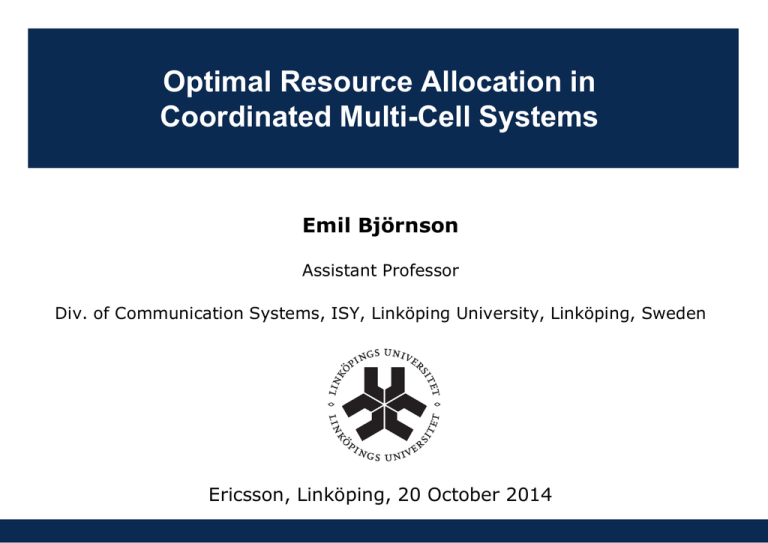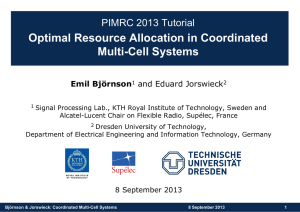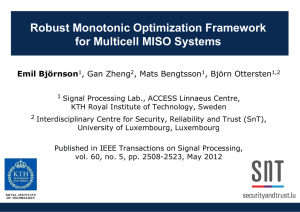Optimal Resource Allocation in Coordinated Multi
advertisement

Optimal Resource Allocation in
Coordinated Multi-Cell Systems
Emil Björnson
Assistant Professor
Div. of Communication Systems, ISY, Linköping University, Linköping, Sweden
Ericsson, Linköping, 20 October 2014
Biography: Emil Björnson
• 1983: Born in Malmö, Sweden
• 2007: Master of Science in
Engineering Mathematics,
Lund University, Sweden
• 2011: PhD in Telecommunications,
KTH, Stockholm, Sweden
- Advisors: Björn Ottersten, Mats Bengtsson
• 2012-2014: Postdoc at SUPELEC, Gif-sur-Yvette, France,
- Recipient of International Postdoc Grant from Sweden
• 2014: Assistant Professor at Linköping University
- Topics: Massive MIMO, energy-efficiency, network optimization
Björnson: Optimal Resource Allocation in Coordinated Multi-Cell Systems
20 October 2014
2
Book Reference
• Seminar Based on Our Recent Book:
Optimal Resource Allocation in
Coordinated Multi-Cell Systems
Research book by E. Björnson and E. Jorswieck
Foundations and Trends in Communications
and Information Theory,
Vol. 9, No. 2-3, pp. 113-381, 2013
- 270 pages
- E-book for free (from our homepages)
- Printed book: Special price $35, use link:
https://ecommerce.nowpublishers.com/shop/add_to_cart?id=1595
- Matlab code is available online
Check out: http://www.commsys.isy.liu.se/en/staff/emibj29
Björnson: Optimal Resource Allocation in Coordinated Multi-Cell Systems
20 October 2014
3
Outline
• Introduction
- Multi-cell structure, system model, performance measure
• Problem Formulation
- Resource allocation: Multi-objective optimization problem
• Subjective Resource Allocation
- Utility functions, different computational complexity
• Structural Insights
- Beamforming parametrization
• Extensions to Practical Conditions
- Handling non-idealities in practical systems
Björnson: Optimal Resource Allocation in Coordinated Multi-Cell Systems
20 October 2014
4
Section
Introduction
Björnson: Optimal Resource Allocation in Coordinated Multi-Cell Systems
20 October 2014
5
Introduction
• Problem Formulation (vaguely):
- Transfer information wirelessly to users
- Divide radio resources among users (time, frequency, space)
• Downlink Coordinated Multi-Cell System
- Many transmitting base stations (BSs)
- Many receiving users
• Sharing a Frequency Band
- All signals reach everyone!
• Limiting Factor
- Inter-user interference
Björnson: Optimal Resource Allocation in Coordinated Multi-Cell Systems
20 October 2014
6
Introduction: Multi-Antenna Single-Cell Transmission
• Traditional Ways to Manage Interference
- Avoid and suppress in time and frequency domain
- Results in orthogonal single-cell access techniques: TDMA, OFDMA, etc.
• Multi-Antenna Transmission
Main difference from
classical resource
allocation!
- Beamforming: Spatially directed signals
- Adaptive control of interference
- Serve multiple users: Space-division multiple access (SDMA)
Björnson: Optimal Resource Allocation in Coordinated Multi-Cell Systems
20 October 2014
7
Introduction: From Single-Cell to Multi-Cell
• Naïve Multi-Cell Extension
-
Divide BS into disjoint clusters
SDMA within each cluster
Avoid inter-cluster interference
Fractional frequency-reuse
• Coordinated Multi-Cell Transmission
- SDMA in multi-cell: Cooperation between all BSs
- Full frequency-reuse: Interference managed by beamforming
- Many names: co-processing,
coordinated multi-point (CoMP),
network MIMO,
multi-cell processing
• Almost as One Super-Cell
- But: Different data knowledge, channel knowledge, power constraints!
Björnson: Optimal Resource Allocation in Coordinated Multi-Cell Systems
20 October 2014
8
Basic Multi-Cell Coordination Structure
• General Multi-Cell Coordination
- Adjacent base stations coordinate interference
- Some users served by multiple base stations
Dynamic Cooperation Clusters
• Inner Circle
: Serve users with data
• Outer Circle : Suppress interference
• Outside Circles:
Negligible impact
Impractical to acquire information
Difficult to coordinate decisions
• E. Björnson, N. Jaldén, M. Bengtsson, B. Ottersten,
“Optimality Properties, Distributed Strategies, and
Measurement-Based Evaluation of Coordinated
Multicell OFDMA Transmission,” IEEE Trans. on Signal
Processing, 2011.
Björnson: Optimal Resource Allocation in Coordinated Multi-Cell Systems
20 October 2014
9
Example: Ideal Joint Transmission
• All Base Stations Serve All Users Jointly = One Super Cell
Björnson: Optimal Resource Allocation in Coordinated Multi-Cell Systems
20 October 2014
10
Example: Wyner Model
• Abstraction: User receives signals from own and
neighboring base stations
• One or Two Dimensional Versions
• Joint Transmission or Coordination between Cells
Björnson: Optimal Resource Allocation in Coordinated Multi-Cell Systems
20 October 2014
11
Example: Coordinated Beamforming
Special Case
Interference
channel
• One Base Station Serves Each User
• Interference Coordination Across Cells
Björnson: Optimal Resource Allocation in Coordinated Multi-Cell Systems
20 October 2014
12
Example: Soft-Cell Coordination
• Heterogeneous Deployment
- Conventional macro BS overlaid by short-distance small BSs
- Interference coordination and joint transmission between layers
Björnson: Optimal Resource Allocation in Coordinated Multi-Cell Systems
20 October 2014
13
Example: Cognitive Radio
Other Examples
Spectrum sharing
between operators
Physical layer
security
• Secondary System Borrows Spectrum of Primary System
- Underlay: Interference limits for primary users
Björnson: Optimal Resource Allocation in Coordinated Multi-Cell Systems
20 October 2014
14
Resource Allocation: First Definition
• Problem Formulation (imprecise):
- Select beamforming to maximize “system utility”
- Means: Allocate power to users and in spatial dimensions
- Satisfy: Physical, regulatory & economic constraints
• Some Assumptions:
- Linear transmission and reception
- Perfect synchronization (whenever needed)
- Flat-fading channels (e.g., using OFDM)
- Perfect channel knowledge
- Ideal transceiver hardware
- Centralized optimization
Relaxed at the end
Björnson: Optimal Resource Allocation in Coordinated Multi-Cell Systems
20 October 2014
15
Multi-Cell System Model
• 𝐾𝑟 Users: Channel vector
to User 𝑘 from all BSs
• 𝑁𝑗 Antennas at 𝑗th BS (dimension of h𝑗𝑘 )
• 𝑁=
𝑗 𝑁𝑗
Antennas in Total (dimension of h𝑘 )
One System Model for All Multi-Cell Scenarios!
Björnson: Optimal Resource Allocation in Coordinated Multi-Cell Systems
20 October 2014
16
Multi-Cell System Model: Dynamic Cooperation Clusters (2)
• How are D𝑘 and C𝑘 Defined?
- This is User 𝑘
- Beamforming: D𝑘 v𝑘
Data only from BS1:
- Effective channel: 𝐂𝐻
𝑘 h𝑘
All BSs coordinate interference:
Example: Coordinated Beamforming
Björnson: Optimal Resource Allocation in Coordinated Multi-Cell Systems
20 October 2014
17
Multi-Cell System Model: Power Constraints
• Need for Power Constraints
-
Limit radiated power according to regulations
Protect dynamic range of amplifiers
Manage cost of energy expenditure
Control interference to certain users
All at the same time!
• 𝐿 General Power Constraints:
Weighting matrix
(Positive semi-definite)
Björnson: Optimal Resource Allocation in Coordinated Multi-Cell Systems
Limit
(Positive scalar)
20 October 2014
18
Multi-Cell System Model: Power Constraints (2)
• Recall:
• Example 1, Total Power Constraint:
• Example 2, Per-Antenna Constraints:
Björnson: Optimal Resource Allocation in Coordinated Multi-Cell Systems
20 October 2014
19
Introduction: How to Measure User Performance?
• Mean Square Error (MSE)
- Difference: transmitted and received signal
- Easy to Analyze
- Far from User Perspective?
All improves
with SINR:
• Bit/Symbol Error Probability (BEP/SEP)
- Probability of error (for given data rate)
- Intuitive interpretation
- Complicated & ignores channel coding
Signal
Interference + Noise
• Information Rate
- Bits per “channel use”
- Mutual information: perfect and long coding
- Anyway closest to reality?
Björnson: Optimal Resource Allocation in Coordinated Multi-Cell Systems
20 October 2014
20
Introduction: Generic Measure User Performance
• Generic Model
- Any function of signal-to-interference-and-noise ratio (SINR):
for User 𝑘
User Specific
- Increasing and continuous function
- For simplicity: 𝑔𝑘 0 = 0
Measure user’s
satisfaction
• Example:
- Information rate:
• Complicated Function
- Depends on all beamforming vectors v1 , … , v𝐾𝑟
Björnson: Optimal Resource Allocation in Coordinated Multi-Cell Systems
20 October 2014
21
Section
Problem Formulation
Björnson: Optimal Resource Allocation in Coordinated Multi-Cell Systems
20 October 2014
22
Problem Formulation
• General Formulation of Resource Allocation:
• Multi-Objective Optimization Problem
- Generally impossible to maximize for all users!
- Must divide power and cause inter-user interference
Björnson: Optimal Resource Allocation in Coordinated Multi-Cell Systems
20 October 2014
23
Performance Region
• Definition: Achievable Performance Region
- Contains all feasible combinations
- Feasible = Achieved by some {v1 , … , v𝐾𝑟 } under power constraints
Care about
user 2
Pareto Boundary
Balance
between
users
Part of interest:
Pareto boundary
2-User
Performance
Region
Care about
user 1
Björnson: Optimal Resource Allocation in Coordinated Multi-Cell Systems
Cannot improve
for any user
without degrading
for other users
Other Names
Rate Region
Capacity Region
MSE Region, etc.
20 October 2014
24
Performance Region (2)
• Can the region have any shape?
• No! Can prove that:
- Compact set
- Normal set
Upper corner in region,
everything inside region
Björnson: Optimal Resource Allocation in Coordinated Multi-Cell Systems
20 October 2014
25
Performance Region (3)
• Some Possible Shapes
User-Coupling
Weak: Convex
Strong: Concave
Scheduling
Time-sharing for
strongly coupled users
Select multiple points
Hard: Unknown region
Björnson: Optimal Resource Allocation in Coordinated Multi-Cell Systems
20 October 2014
26
Performance Region (4)
• Which Pareto Optimal Point to Choose?
- Tradeoff: Aggregate Performance vs. Fairness
Utilitarian point
(Max sum performance)
Utopia point
(Combine user points)
Single
user
point
Performance
Region
Egalitarian point
(Max fairness)
Utopia point
outside of region
Single user point
Björnson: Optimal Resource Allocation in Coordinated Multi-Cell Systems
No Objective
Answer
Only subjective
answers exist!
20 October 2014
27
Section
Subjective Resource Allocation
Björnson: Optimal Resource Allocation in Coordinated Multi-Cell Systems
20 October 2014
28
Subjective Approach
• System Designer Selects Utility Function
- Describes subjective preference
- Increasing and continuous function
Put different weights
to move between
extremes
• Examples:
Sum performance:
Proportional fairness:
Harmonic mean:
Max-min fairness:
Known as A Priori Approach
Select utility function before optimization
Björnson: Optimal Resource Allocation in Coordinated Multi-Cell Systems
20 October 2014
29
Subjective Approach (2)
• Utility Function gives Single-Objective Optimization Problem:
• This is the Starting Point of Many Researchers
- Although selection of is
Inherently subjective
Affects the solvability
- Should always have a motivation in mind!
Pragmatic Approach
Try to Select Utility Function to Enable Efficient Optimization
Björnson: Optimal Resource Allocation in Coordinated Multi-Cell Systems
20 October 2014
30
Complexity of Single-Objective Optimization Problems
• Classes of Optimization Problems
- Different scaling with number of parameters and constraints
• Main Classes
- Convex: Polynomial time solution
Practically solvable
- Monotonic: Exponential time solution
Approximations needed
- Arbitrary: More than exponential time
Hard to even approximate
Björnson: Optimal Resource Allocation in Coordinated Multi-Cell Systems
20 October 2014
31
Classification of Resource Allocation Problems
• Classification of Three Important Problems
- The “Easy” problem
- Weighted max-min fairness
- Weighted sum performance
• We will see: These have Different Complexities
- Difficulty: Too many spatial degrees of freedom
- Convex problem only if search space is particularly limited
- Monotonic problem in general
Björnson: Optimal Resource Allocation in Coordinated Multi-Cell Systems
20 October 2014
32
Complexity Example 1: The “Easy” Problem
• Given Any Point (𝑔1 , … , 𝑔𝐾𝑟 )
- Find beamforming v1 , … , v𝐾𝑟 that attains this point
- Minimize the total power
• Convex Problem
- Second-order cone or semi-definite program
- Global solution in polynomial time – use CVX, Yalmip
- Alternative: Fixed-point iterations (uplink-downlink duality)
Total Power
Constraints
• M. Bengtsson, B. Ottersten, “Optimal Downlink Beamforming Using Semidefinite
Optimization,” Proc. Allerton, 1999.
• A. Wiesel, Y. Eldar, and S. Shamai, “Linear precoding via conic optimization for fixed
MIMO receivers,” IEEE Trans. on Signal Processing, 2006.
Per-Antenna
• W. Yu and T. Lan, “Transmitter optimization for the multi-antenna downlink with
Constraints
per-antenna power constraints,” IEEE Trans. on Signal Processing, 2007.
General
Constraints
• E. Björnson, G. Zheng, M. Bengtsson, B. Ottersten, “Robust Monotonic Optimization
Framework for Multicell MISO Systems,” IEEE Trans. on Signal Processing, 2012.
Björnson: Optimal Resource Allocation in Coordinated Multi-Cell Systems
20 October 2014
33
Complexity Example 2: Max-Min Fairness
• How to Classify Weighted Max-Min Fairness?
- Property: Solution makes 𝑤𝑘 𝑔𝑘 the same for all 𝑘
Solution is on this line
Line in direction (𝑤1 , … , 𝑤𝐾𝑟 )
Björnson: Optimal Resource Allocation in Coordinated Multi-Cell Systems
20 October 2014
34
Complexity Example 2: Max-Min Fairness (2)
• Simple Line-Search: Bisection
- Iteratively Solving Convex Problems (i.e., quasi-convex)
1. Find start interval
2. Solve the “easy” problem
at midpoint
3. If feasible:
Remove lower half
Else: Remove upper half
4. Iterate
Subproblem: Convex optimization
Line-search: Linear convergence
One dimension (independ. #users)
Björnson: Optimal Resource Allocation in Coordinated Multi-Cell Systems
20 October 2014
35
Complexity Example 2: Max-Min Fairness (3)
• Classification of Weighted Max-Min Fairness:
- Quasi-convex problem (belongs to convex class)
- Polynomial complexity in #users, #antennas, #constraints
- Might be feasible complexity in practice
Early work
Main
references
• T.-L. Tung and K. Yao, “Optimal downlink power-control design methodology for a
mobile radio DS-CDMA system,” in IEEE Workshop SIPS, 2002.
• M. Mohseni, R. Zhang, and J. Cioffi, “Optimized transmission for fading multipleaccess and broadcast channels with multiple antennas,” IEEE Journal on Sel. Areas
in Communications, 2006.
• A. Wiesel, Y. Eldar, and S. Shamai, “Linear precoding via conic optimization for fixed
MIMO receivers,” IEEE Trans. on Signal Processing, 2006.
Channel
uncertainty
• E. Björnson, G. Zheng, M. Bengtsson, B. Ottersten, “Robust Monotonic Optimization
Framework for Multicell MISO Systems,” IEEE Trans. on Signal Processing, 2012.
Björnson: Optimal Resource Allocation in Coordinated Multi-Cell Systems
20 October 2014
36
Complexity Example 3: Weighted Sum Performance
• How to Classify Weighted Sum Performance?
- Geometrically: 𝑤1 𝑔1 + 𝑤2 𝑔2 = opt-value is a line
Opt-value is unknown!
-
Distance from origin is unknown
Line Hyperplane (dim: #user – 1)
Harder than max-min fairness
Non-convex problem
Björnson: Optimal Resource Allocation in Coordinated Multi-Cell Systems
20 October 2014
37
Complexity Example 3: Weighted Sum Performance (2)
• Classification of Weighted Sum Performance:
-
Non-convex problem
Power constraints: Convex
Utility: Monotonic increasing/decreasing in beamforming vectors
Therefore: Monotonic problem
• Can There Be a Magic Algorithm?
- No, provably NP-hard (Non-deterministic Polynomial-time hard)
- Exponential complexity but in which parameters?
(#users, #antennas, #constraints)
• Z.-Q. Luo and S. Zhang, “Dynamic spectrum management: Complexity and duality,” IEEE Journal
of Sel. Topics in Signal Processing, 2008.
• Y.-F. Liu, Y.-H. Dai, and Z.-Q. Luo, “Coordinated beamforming for MISO interference channel:
Complexity analysis and efficient algorithms,” IEEE Trans. on Signal Processing, 2011.
Björnson: Optimal Resource Allocation in Coordinated Multi-Cell Systems
20 October 2014
38
Complexity Example 3: Weighted Sum Performance (3)
• Are Monotonic Problems Impossible to Solve?
- No, not for small problems!
• Monotonic Optimization Algorithms
- Improve Lower/upper bounds on optimum:
- Continue until
- Subproblem: Essentially weighted max-min fairness problem
Monotonic
• H. Tuy, “Monotonic optimization: Problems and solution approaches,” SIAM Journal
optimization
of Optimization, 2000.
Early works
• L. Qian, Y. Zhang, and J. Huang, “MAPEL: Achieving global optimality for a nonconvex wireless power control problem,” IEEE Trans. on Wireless Commun., 2009.
• E. Jorswieck, E. Larsson, “Monotonic Optimization Framework for the MISO
Interference Channel,” IEEE Trans. on Communications, 2010.
Polyblock
algorithm
• W. Utschick and J. Brehmer, “Monotonic optimization framework for coordinated
beamforming in multicell networks,” IEEE Trans. on Signal Processing, 2012.
BRB
algorithm
• E. Björnson, G. Zheng, M. Bengtsson, B. Ottersten, “Robust Monotonic Optimization
Framework for Multicell MISO Systems,” IEEE Trans. on Signal Processing, 2012.
Björnson: Optimal Resource Allocation in Coordinated Multi-Cell Systems
20 October 2014
39
Complexity Example 3: Weighted Sum Performance (4)
Branch-Reduce-Bound
(BRB) Algorithm
- Global convergence
- Accuracy ε>0 in finitely
many iterations
- Exponential complexity
only in #users (𝐾𝑟 )
- Polynomial complexity
in other parameters
(#antennas, #constraints)
Björnson: Optimal Resource Allocation in Coordinated Multi-Cell Systems
20 October 2014
40
Summary: Complexity of Resource Allocation Problems
• Recall: All Utility Functions are Subjective
- Pragmatic approach: Select to enable efficient optimization
• Good Choice: Any Problem with Polynomial complexity
- Example: Weighted max-min fairness
- Use weights to adapt to other system needs
• Bad Choice: Weighted Sum Performance
- Generally NP-hard: Exponential complexity (in #users)
- Should be avoided – Sometimes needed (virtual queuing techniques)
Björnson: Optimal Resource Allocation in Coordinated Multi-Cell Systems
20 October 2014
41
Summary: Complexity of Resource Allocation Problems (2)
• Complexity Analysis for Any Dynamic Cooperation Clusters
- Same optimization algorithms!
- Extra characteristics can sometime simplify
- Multi-antenna transmission: Higher complexity, higher performance
Ideal Joint
Transmission
Coordinated
Beamforming
Björnson: Optimal Resource Allocation in Coordinated Multi-Cell Systems
Underlay
Cognitive Radio
20 October 2014
42
Section
Structural Insights
Björnson: Optimal Resource Allocation in Coordinated Multi-Cell Systems
20 October 2014
43
Parametrization of Optimal Beamforming
• 𝐾𝑟 𝑁 Complex Optimization Variables: Beamforming vectors v1 , … , v𝐾𝑟
- Can be reduced to 𝐾𝑟 − 1 positive parameters (for 𝐿 = 1)
• Any Resource Allocation Problem Solved by
𝑟
(C𝑘 = D𝑘 = 𝐈𝑁 for brevity)
- Priority of User 𝑘: 𝜆𝑘
Lagrange multipliers of “Easy” problem
Björnson: Optimal Resource Allocation in Coordinated Multi-Cell Systems
20 October 2014
44
Parametrization of Optimal Beamforming (2)
• Geometric Interpretation:
Tradeoff
- Maximize signal vs.
minimize interference
- Selfishness vs. altruism
- Hard to find optimal tradeoff
- 𝐾𝑟 = 2: Simple special case
• Heuristic Parameter Selection
- Known to work remarkably well
- Many Examples (since 1995): Transmit Wiener filter, Regularized Zeroforcing, Signal-to-leakage beamforming, Virtual SINR beamforming, etc.
• E. Björnson, M. Bengtsson, B. Ottersten, “Optimal Multiuser Transmit Beamforming: A Difficult
Problem with a Simple Solution Structure,” IEEE Signal Processing Magazine, 2014.
Björnson: Optimal Resource Allocation in Coordinated Multi-Cell Systems
20 October 2014
45
Section
Extensions to Practical Conditions
Björnson: Optimal Resource Allocation in Coordinated Multi-Cell Systems
20 October 2014
46
Robustness to Channel Uncertainty
• Practical Systems Operate under Uncertainty
- Due to estimation, feedback, delays, etc.
• Robustness to Uncertainty
- Maximize worst-case performance
- Cannot be robust to any error
• Ellipsoidal Uncertainty Sets
- Easily incorporated in system model
- Same classifications – More variables
- Definition:
Björnson: Optimal Resource Allocation in Coordinated Multi-Cell Systems
20 October 2014
47
Distributed Resource Allocation
• Information and Functionality is Distributed
- Local channel Knowledge and computational resources
- Only limited backhaul for coordination
• Distributed Approach
- Decompose optimization
- Exchange control signals
- Iterate subproblems
• Convergence to Optimal Solution?
- At least for convex problems
Björnson: Optimal Resource Allocation in Coordinated Multi-Cell Systems
20 October 2014
48
Adapting to Transceiver Hardware Impairments
• Physical Hardware is Non-Ideal
- Phase noise, IQ-imbalance, non-linearities, etc.
- Reduced calibration/compensation: Residual distortion remains!
- Non-negligible performance degradation at high SNRs
• Model of Residual Transmitter Distortion:
- Additive noise
- Variance scales with
signal power
• Same Classifications Hold under this Model
- Enables adaptation: Much larger tolerance for impairments
Björnson: Optimal Resource Allocation in Coordinated Multi-Cell Systems
20 October 2014
49
Summary
Björnson: Optimal Resource Allocation in Coordinated Multi-Cell Systems
20 October 2014
50
Summary
• Multi-Cell Multi-Antenna Resource Allocation
- Divide power between users and spatial directions
- Solve a multi-objective optimization problem
- Pareto boundary: Set of efficient solutions
• Subjective Utility Function
-
Selection has fundamental impact on solvability
Multi-antenna transmission: More possibilities – higher complexity
Pragmatic approach: Select to enable efficient optimization
Polynomial complexity: Weighted max-min fairness
Not solvable in practice: Weighted sum performance
• Parametrization of Optimal Beamforming
• Practical Extensions
- Channel uncertainty, Distributed optimization, Hardware impairments
Björnson: Optimal Resource Allocation in Coordinated Multi-Cell Systems
20 October 2014
51
Main Reference: Our Book
• Thorough Resource Allocation Framework
- More parametrizations and structural insights
- Guidelines for scheduling and forming clusters
- Matlab code distributed for algorithms
- Other Convex Problems and Optimization Algorithms:
General
Zero Forcing Single Antenna
Sum Performance
NP-hard
Convex
NP-hard
Max-Min Fairness
Quasi-Convex
Quasi-Convex
Quasi-Convex
“Easy” Problem
Convex
Convex
Linear
Proportional Fairness
NP-hard
Convex
Convex
Harmonic Mean
NP-hard
Convex
Convex
• Further Extensions:
- Multi-cast, Multi-carrier, Multi-antenna users, etc.
Björnson: Optimal Resource Allocation in Coordinated Multi-Cell Systems
20 October 2014
52
Questions?
My papers and presentations are available online:
http://www.commsys.isy.liu.se/en/staff/emibj29
Björnson: Optimal Resource Allocation in Coordinated Multi-Cell Systems
20 October 2014
53








